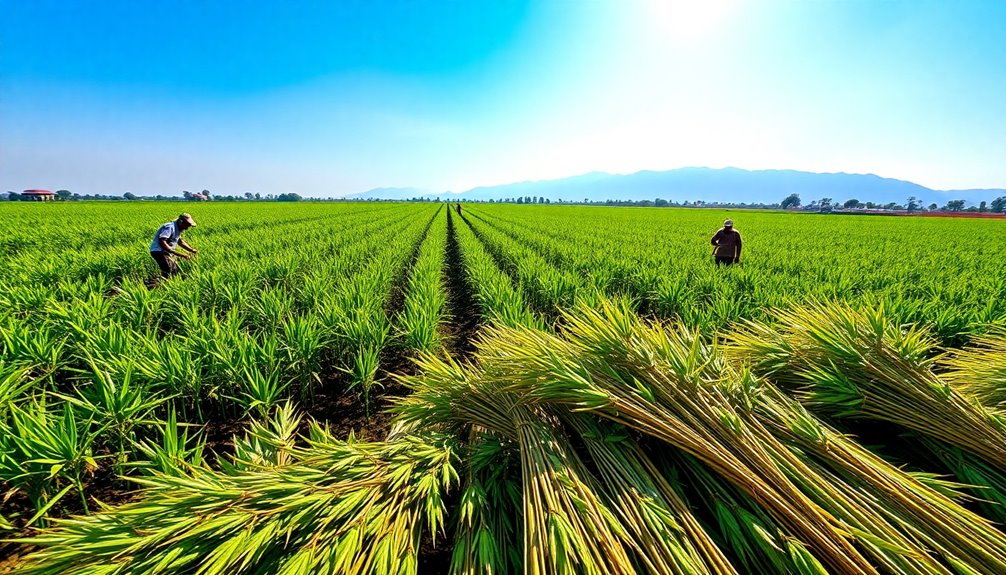Nepal's industrial hemp has immense potential due to its ideal growth conditions and unique geography. You'll find it thrives at high altitudes, is drought-resistant, and can yield multiple crops yearly. Despite its advantages, legal restrictions hinder its cultivation. However, traditional processing methods reveal rich craftsmanship and organic quality. Legalizing hemp could create jobs and boost the local economy while offering sustainable practices. Discover how embracing this crop could transform Nepal's agricultural landscape and market opportunities.
Key Takeaways
- Industrial hemp thrives in Nepal's unique geography, particularly at altitudes around 3,000 meters, benefiting from the region's climate.
- Current legal restrictions hinder the cultivation of industrial hemp, limiting economic opportunities for local communities reliant on wild hemp.
- Traditional processing methods, primarily performed by women, involve labor-intensive techniques for extracting and transforming hemp fibers into various products.
- Legalizing industrial hemp cultivation could significantly enhance sustainable farming practices, reducing chemical usage and improving soil health.
- Combining traditional techniques with modern processing could increase the marketability and value of hemp products in Nepal.

Nepal's industrial hemp cultivation holds a rich potential that remains largely untapped due to legal restrictions. You mightn't know that hemp is native to Nepal and thrives in several districts at upper-middle altitudes. Currently, industrial hemp cultivation is illegal, forcing many to rely on wild hemp sourced from forested hillsides. This wild hemp is often harvested without the use of pesticides or chemical fertilizers, highlighting its organic quality.
Growing at around 3,000 meters above sea level, hemp benefits from Nepal's unique geography and climate. The steep hillside regions are perfect for hemp, which boasts drought-resistant properties. You'll find that Nepal's climatic conditions support multiple hemp crops each year, making it an ideal setting for cultivation. Additionally, the fashion industry generates approximately 92 million tons of waste annually, underscoring the urgent need for sustainable alternatives like hemp. Cultivating hemp could also contribute to deforestation reduction efforts by providing a sustainable crop that requires fewer chemicals and less water than traditional farming.
Hemp is also versatile, tolerating a range of soil conditions, which helps improve overall soil health. In areas like West Nepal, especially Darchula, there's a rich tradition of hemp collection and usage. You can see how rural communities have preserved traditional methods for processing hemp.
This manual extraction involves soaking, separating, twisting, drying, and spinning fibers, often carried out by women in the community. They skillfully create various items such as cloth, ropes, and mats using hemp fibers. Handloom weaving remains a common practice, showcasing the artistry involved in transforming raw hemp into functional products.
Despite the current legal barriers, the value-adding potential of industrial hemp in Nepal is significant. By legalizing cultivation, you could witness a surge in local economies, job creation, and sustainable practices. The traditional techniques hold immense value, and combining them with modern practices could enhance product quality and marketability.
It's clear that embracing industrial hemp could provide both environmental benefits and economic opportunities. As you explore the possibilities, consider how this ancient plant could reshape Nepal's agricultural landscape.
Frequently Asked Questions
What Are the Legal Restrictions on Hemp Cultivation in Nepal?
In Nepal, hemp cultivation is technically illegal due to its classification alongside marijuana, primarily because of THC content.
You'll find that the Narcotic Drugs (Control) Act allows wild hemp use but restricts cultivation unless you obtain a special government license.
This confusing legal framework has led to calls for clearer regulations.
While proposed reforms aim to establish a legal framework for hemp, they're still pending government approval, leaving many uncertainties for potential growers.
How Does Nepal's Climate Affect Hemp Growth?
Nepal's climate greatly benefits hemp growth.
You'll find that the country's annual rainfall, averaging around 59 inches, exceeds hemp's needs. The temperature range of 5.6°C to 27.5°C supports healthy development, while high humidity enhances growth even further.
Additionally, the seasonal pattern allows for a 120-day growth cycle, leading to harvest in autumn.
With such favorable conditions, you can expect robust hemp cultivation throughout Nepal's diverse regions.
What Pests or Diseases Commonly Affect Hemp Plants?
Hemp plants can face various pests and diseases that threaten their health.
You might encounter issues like gray mold caused by *Botrytis cinerea*, or rust from *Uredo kriegeriana*.
Insects like cannabis aphids and the Eurasian hemp borer can damage your plants significantly.
Additionally, watch for viral infections like the Alfalfa Mosaic Virus, which causes yellowing leaves.
Keeping an eye on these problems will help maintain your hemp's vitality and yield.
What Are the Potential Environmental Impacts of Hemp Farming?
When you consider hemp farming, you'll notice both positive and negative environmental impacts.
On the plus side, hemp sequesters carbon, improves soil health, and promotes biodiversity.
However, intensive cultivation can lead to high resource use and greenhouse gas emissions.
While hemp needs water, it conserves it efficiently through deep roots.
Balancing these factors is key to maximizing hemp's benefits while minimizing its environmental challenges in your agricultural practices.
How Can Farmers Access Hemp Seeds in Nepal?
Imagine standing in a field, the sun warming your back, but feeling frustrated because you can't find quality hemp seeds.
To access seeds in Nepal, you'll need to navigate the tangled web of local resources and wild plants. Often, farmers rely on what's available around them, but you can seek out community networks or local farmers to share seeds.
Advocating for clearer regulations could open doors to better seed access and future growth.
Conclusion
In the grand tapestry of Nepal's agriculture, industrial hemp is a vibrant thread weaving together sustainability and economic potential. Just as a skilled weaver transforms simple fibers into intricate patterns, you can nurture hemp to create a flourishing industry. With its low environmental impact and multitude of uses, hemp isn't just a plant; it's a gateway to innovation. By embracing this versatile crop, you're not just cultivating land—you're cultivating a brighter future for your community and beyond.









